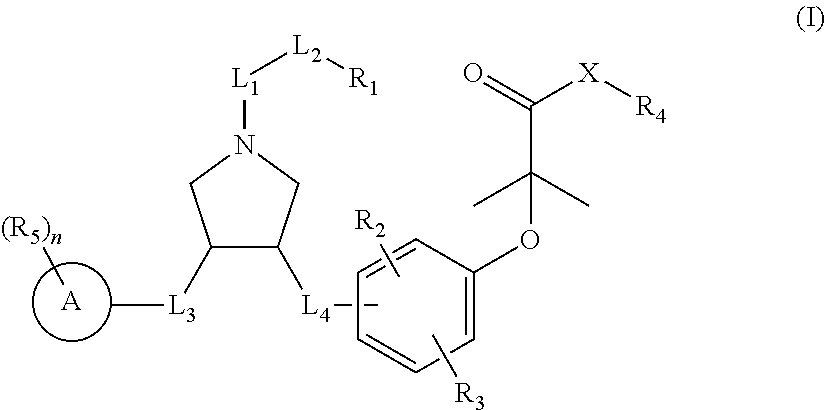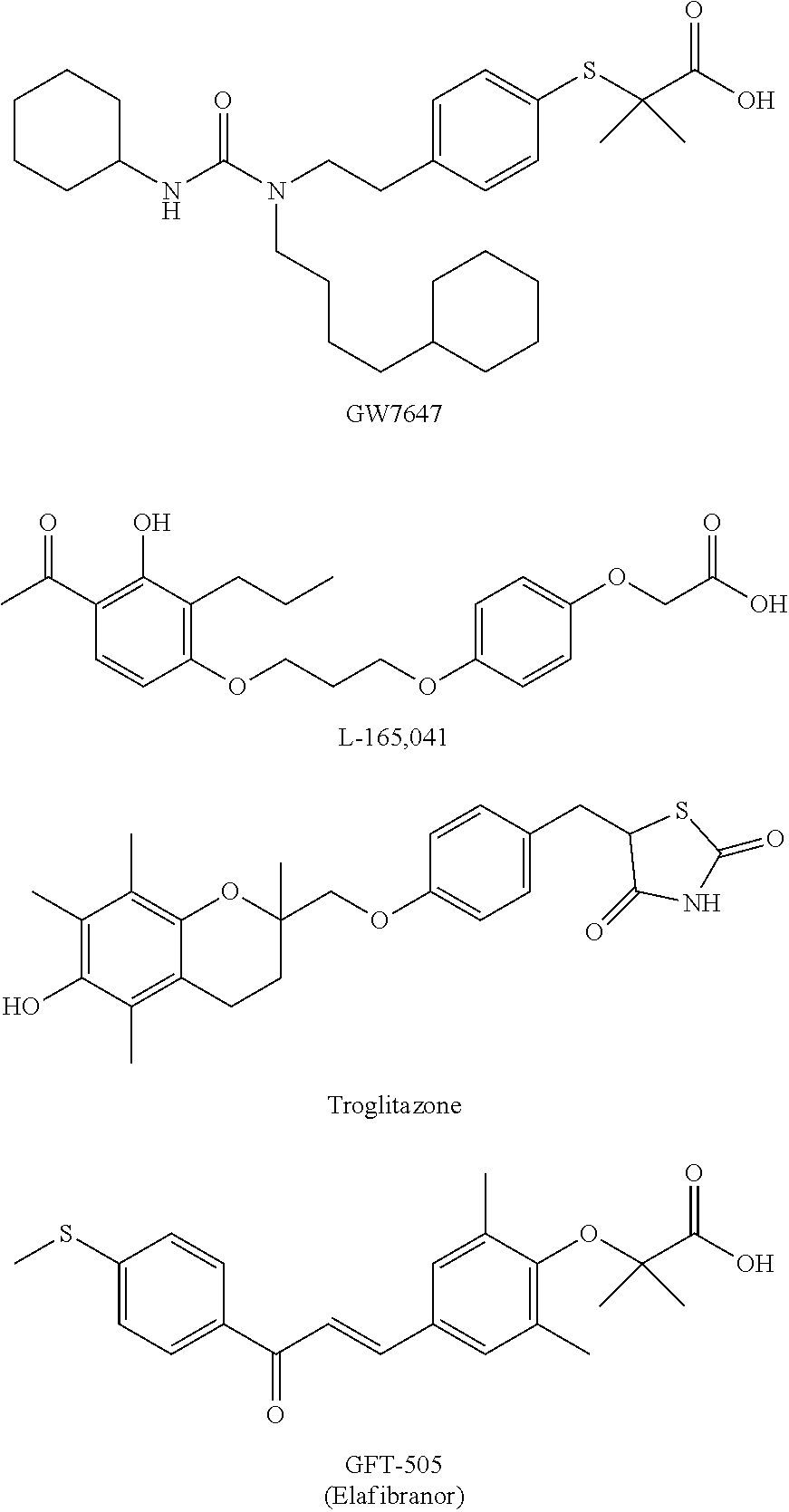Pyrrolidine derivatives as PPAR agonists
a technology of pyrrolidine derivatives and ppar, which is applied in the field of pyrrolidine derivatives as ppar agonists, can solve the problems of not having a fda-approved medicament for the treatment of such diseases, and achieve the effects of improving safety, reducing side effects, and improving safety
- Summary
- Abstract
- Description
- Claims
- Application Information
AI Technical Summary
Benefits of technology
Problems solved by technology
Method used
Image
Examples
example 1
1
[0125]
Step 1: Compound 1-c
[0126]A solution of Compound 1-a (5.00 g, 30.08 mmol, 1.00 eq) and Compound 1-b (4.52 g, 30.08 mmol, 1.00 eq) in HCl / MeOH (4 N, 40.01 mL, 5.32 eq) was stirred at 20° C. for 16 h. The reaction mixture was concentrated under reduced pressure to give a crude product. The crude product was washed with dichloromethane / MeOH solution (1:1, 50 mL) to give Compound 1-c.
[0127]MS m / z (ESI): 298.9 [M+1].
Step 2: Compound 1-e
[0128]A solution of Compound 1-c (2.00 g, 6.70 mmol, 1.00 eq), Compound 1-d (2.99 g, 13.40 mmol, 2.49 mL, 2.00 eq), potassium carbonate (1.85 g, 13.40 mmol, 2.00 eq) and potassium iodide (111.26 mg, 670.00 μmol, 0.10 eq) in dimethylsulfoxide (30.00 mL) was stirred under nitrogen protection at 90° C. for 12 h. Water (30 mL) was added into the reaction mixture, and extracted with ethyl acetate (30 mL×3). The combined organic phase was washed with water (20 mL×2) and saturated brine (20 mL×2), dried over anhydrous sodium sulfate, filtered, and concentr...
example 2
2
[0136]
Step 1: Compound 2-b
[0137]Under nitrogen protection, a solution of Compounds 1-e (200.00 mg, 453.94 μmol, 1.00 eq) and 2-a (129.32 mg, 544.73 μmol, 1.20 eq) in toluene (3.00 mL) was added dropwise with trifluoroacetic acid (50.00 μL) at 0° C. The mixture was stirred at 20° C. for 1 h. The mixture was adjusted with a saturated solution of sodium bicarbonate to pH-7. The organic phase was concentrated under reduced pressure. The residue was purified by silica gel column chromatography (petroleum ether / ethyl acetate=5:1) to give Compound 2-b.
[0138]MS m / z (ESI): 574.3 [M+1].
[0139]1H NMR (400 MHz, CDCl3) δ ppm 7.67 (d, J=8.5 Hz, 2H), 7.40-7.36 (m, 2H), 7.32 (t, J=7.3 Hz, 2H), 7.26-7.22 (m, 1H), 7.14 (d, J=8.5 Hz, 2H), 6.88 (s, 2H), 3.93-3.85 (m, 1H), 3.75-3.62 (m, 3H), 3.11 (t, J=8.9 Hz, 1H), 3.01 (t, J=8.7 Hz, 1H), 2.89 (dd, J=6.9, 9.2 Hz, 1H), 2.82 (dd, J=6.3, 9.3 Hz, 1H), 2.48 (s, 3H), 2.18 (s, 6H), 1.50 (s, 9H), 1.41 (s, 6H).
Step 2: Compound 2
[0140]A HCl / ethyl acetate solution...
example 3
3
[0143]
Step 1
Compound 3-a
[0144]A solution of Compound 2-b (1.00 g, 1.74 mmol, 1.00 eq) and 1-chloroethyl methylclhlorofonmate (746.30 mg, 5.22 mmol, 3.00 eq) in 1,2-dichloroethane (10.00 mL) was stirred at 80° C. for 8 h. The mixture was concentrated under reduced pressure. Then, methanol (10.00 mL) was added into the residue, heated to 80° C., and stirred for 1 h. The mixture was concentrated under reduced pressure. The residue was purified by silica gel column chromatography (petroleum ether / ethyl acetate=5 / 1) to give Compound 3-a.
[0145]MS m / z (ESI): 442.1 [M+1].
[0146]1H NMR (400 MHz, CDCl3) δ ppm 7.57 (d, J=8.5 Hz, 2H), 7.09 (d, J=8.5 Hz, 2H), 6.91 (s, 2H), 4.22 (q, J=8.2 Hz, 1H), 3.94-3.74 (m, 6H), 3.71-3.52 (m, 2H), 2.47 (s, 3H), 2.11 (s, 6H), 1.40 (d, J=4.8 Hz, 6H).
Step 2: Compound 3
[0147]A sodium hydroxide solution (2 N, 339.69 μL, 3.00 eq) was added into a solution of Compound 3-a (100.00 mg, 226.46 μmol, 1.00 eq) in ethanol (3.00 mL) at 20° C. The mixture was stirred at 20°...
PUM
| Property | Measurement | Unit |
|---|---|---|
| Fraction | aaaaa | aaaaa |
| Power | aaaaa | aaaaa |
| Pharmaceutically acceptable | aaaaa | aaaaa |
Abstract
Description
Claims
Application Information
 Login to View More
Login to View More - R&D
- Intellectual Property
- Life Sciences
- Materials
- Tech Scout
- Unparalleled Data Quality
- Higher Quality Content
- 60% Fewer Hallucinations
Browse by: Latest US Patents, China's latest patents, Technical Efficacy Thesaurus, Application Domain, Technology Topic, Popular Technical Reports.
© 2025 PatSnap. All rights reserved.Legal|Privacy policy|Modern Slavery Act Transparency Statement|Sitemap|About US| Contact US: help@patsnap.com



